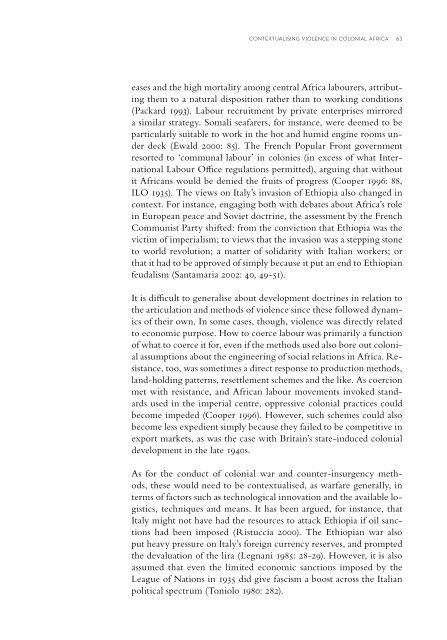60 years after the UN Convention - Dag Hammarskjöld Foundation
60 years after the UN Convention - Dag Hammarskjöld Foundation
60 years after the UN Convention - Dag Hammarskjöld Foundation
Create successful ePaper yourself
Turn your PDF publications into a flip-book with our unique Google optimized e-Paper software.
contextualising violence in colonial africa 63<br />
eases and <strong>the</strong> high mortality among central Africa labourers, attributing<br />
<strong>the</strong>m to a natural disposition ra<strong>the</strong>r than to working conditions<br />
(Packard 1993). Labour recruitment by private enterprises mirrored<br />
a similar strategy. Somali seafarers, for instance, were deemed to be<br />
particularly suitable to work in <strong>the</strong> hot and humid engine rooms under<br />
deck (Ewald 2000: 85). The French Popular Front government<br />
resorted to ‘communal labour’ in colonies (in excess of what International<br />
Labour Offi ce regulations permitted), arguing that without<br />
it Africans would be denied <strong>the</strong> fruits of progress (Cooper 1996: 88,<br />
ILO 1935). The views on Italy’s invasion of Ethiopia also changed in<br />
context. For instance, engaging both with debates about Africa’s role<br />
in European peace and Soviet doctrine, <strong>the</strong> assessment by <strong>the</strong> French<br />
Communist Party shifted: from <strong>the</strong> conviction that Ethiopia was <strong>the</strong><br />
victim of imperialism; to views that <strong>the</strong> invasion was a stepping stone<br />
to world revolution; a matter of solidarity with Italian workers; or<br />
that it had to be approved of simply because it put an end to Ethiopian<br />
feudalism (Santamaria 2002: 40, 49-51).<br />
It is diffi cult to generalise about development doctrines in relation to<br />
<strong>the</strong> articulation and methods of violence since <strong>the</strong>se followed dynamics<br />
of <strong>the</strong>ir own. In some cases, though, violence was directly related<br />
to economic purpose. How to coerce labour was primarily a function<br />
of what to coerce it for, even if <strong>the</strong> methods used also bore out colonial<br />
assumptions about <strong>the</strong> engineering of social relations in Africa. Resistance,<br />
too, was sometimes a direct response to production methods,<br />
land-holding patterns, resettlement schemes and <strong>the</strong> like. As coercion<br />
met with resistance, and African labour movements invoked standards<br />
used in <strong>the</strong> imperial centre, oppressive colonial practices could<br />
become impeded (Cooper 1996). However, such schemes could also<br />
become less expedient simply because <strong>the</strong>y failed to be competitive in<br />
export markets, as was <strong>the</strong> case with Britain’s state-induced colonial<br />
development in <strong>the</strong> late 1940s.<br />
As for <strong>the</strong> conduct of colonial war and counter-insurgency methods,<br />
<strong>the</strong>se would need to be contextualised, as warfare generally, in<br />
terms of factors such as technological innovation and <strong>the</strong> available logistics,<br />
techniques and means. It has been argued, for instance, that<br />
Italy might not have had <strong>the</strong> resources to attack Ethiopia if oil sanctions<br />
had been imposed (Ristuccia 2000). The Ethiopian war also<br />
put heavy pressure on Italy’s foreign currency reserves, and prompted<br />
<strong>the</strong> devaluation of <strong>the</strong> lira (Legnani 1985: 28-29). However, it is also<br />
assumed that even <strong>the</strong> limited economic sanctions imposed by <strong>the</strong><br />
League of Nations in 1935 did give fascism a boost across <strong>the</strong> Italian<br />
political spectrum (Toniolo 1980: 282).

















